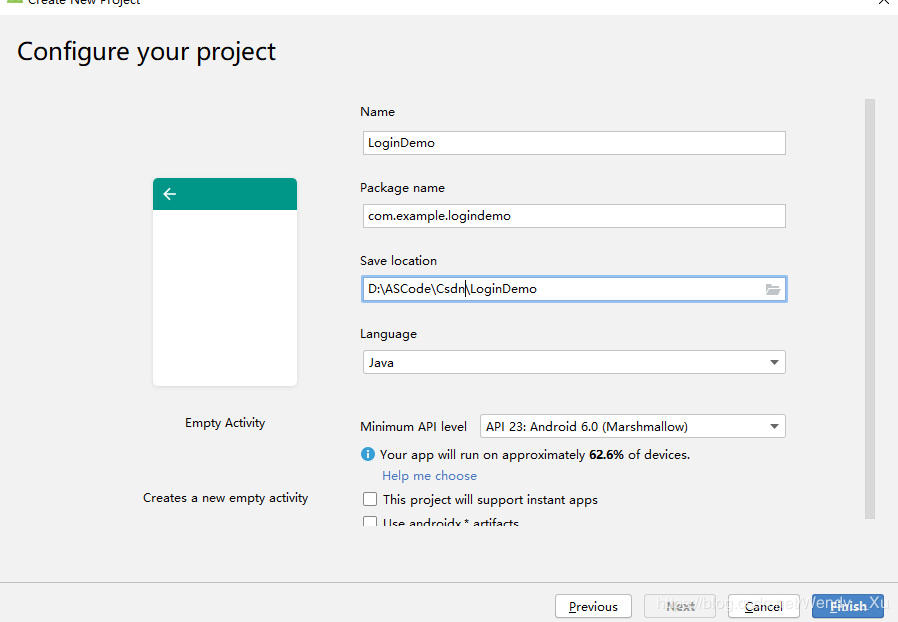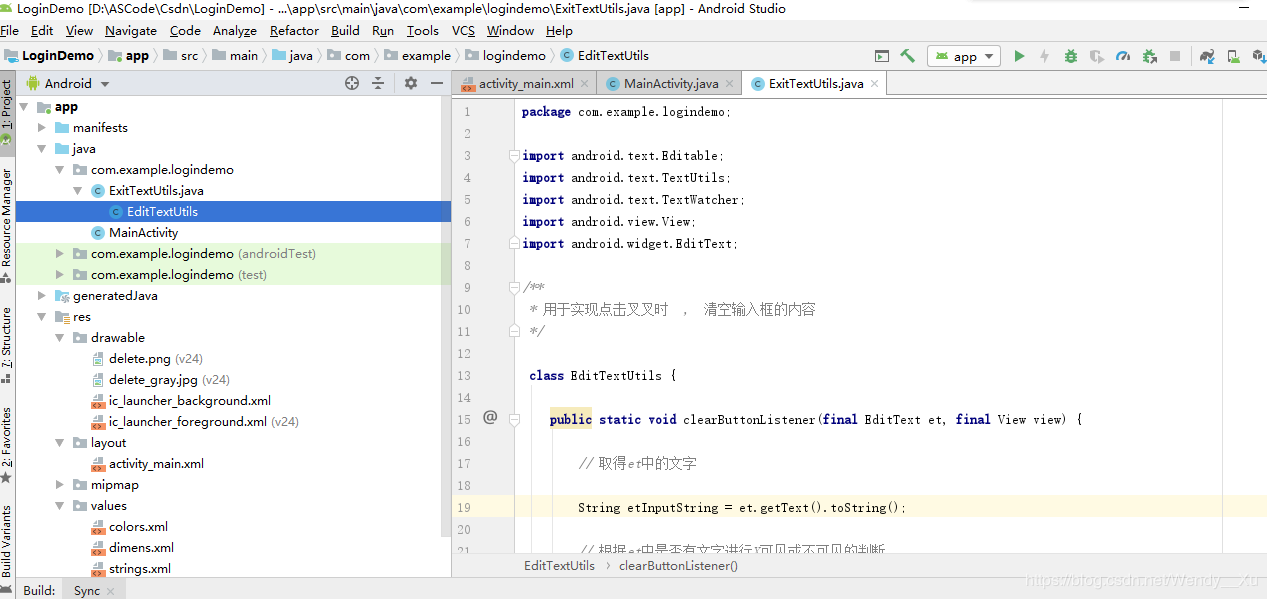详解Android Studio实现用户登陆界面demo(xml实现)
使用Android Studio 编写的第一个demo,使用布局文件—xml实现用户登录界面
注:所建工程均为Android 6.0 所以只要是Android 6.0(包括6.0)以上的真机,模拟机都可以使用
Step1:Android Studio 开发环境的搭建:
1.安装JDK (1.8);2.安装Android studio (3.3.1) 包含 gradle、sdk manage 、avd manage ;3.使用sdk manage 下载安装 sdk;4.使用avd manages 创建虚拟机
Step2: 新建工程项目Myapp2.0


1.在res/layout/activity_main.xml中编写布局内容:
<LinearLayout android:layout_width='match_parent' android:layout_height='match_parent' android:orientation='vertical' android:paddingLeft='55px' android:paddingRight='50px' tools:context='.MainActivity'> <TextView android: android:layout_width='wrap_content' android:layout_height='wrap_content' android:layout_marginStart='@dimen/activity_horizontal_margin' android:layout_marginLeft='@dimen/activity_horizontal_margin' android:layout_marginTop='@dimen/activity_vertical_margin' android:text='Hello Word!' app:layout_constraintLeft_toLeftOf='parent' app:layout_constraintTop_toTopOf='parent' /> <View android:layout_width='match_parent' android:layout_height='2px' android:layout_marginTop='16px' android:background='#000000' /> <TextView android:layout_width='wrap_content' android:layout_height='wrap_content' android:textSize='28dp' android:layout_gravity='center_horizontal' android:layout_marginTop='20px' android:text='登陆界面' /><LinearLayout android:layout_width='match_parent' android:layout_height='wrap_content' android:orientation='horizontal' > <EditText android: android:layout_width='280dp' android:layout_height='wrap_content' android:layout_marginTop='30dp' android:paddingLeft='10dp' android:hint='请输入账号' android:inputType='text'/> <ImageView android: android:layout_width='25dp' android:layout_height='25dp' android:layout_marginTop='37dp' android:src='https://www.haobala.com/bcjs/@drawable/delete' /></LinearLayout> <LinearLayout android:layout_width='match_parent' android:layout_height='wrap_content' android:orientation='horizontal' android:paddingLeft='8px'> <EditText android: android:layout_width='280dp' android:layout_height='wrap_content' android:layout_marginTop='26dp' android:hint='请输入密码' android:inputType='textPassword' /> <ImageView android: android:layout_width='25dp' android:layout_height='25dp' android:layout_marginTop='33dp' android:src='https://www.haobala.com/bcjs/@drawable/delete' /></LinearLayout> <Button android: android:layout_width='match_parent' android:layout_height='48dp' android:background='@color/bbutton_danger_disabled_edge' android:layout_marginTop='30dp' android:text='登 陆' android:textSize='30dp' android:textColor='@color/bbutton_danger'/> <Button android: android:layout_width='wrap_content' android:layout_height='wrap_content' android:textSize='15dp' android:layout_gravity='right' android:layout_marginTop='20px' android:background='@color/bbutton_danger' android:text='Adapter' /> </LinearLayout>
2.创建一个Java class —ExitTextUtils用于封装清空输入框的内容 :
/** * 用于实现点击叉叉时 , 清空输入框的内容 */ class EditTextUtils { public static void clearButtonListener(final EditText et, final View view) { // 取得et中的文字 String etInputString = et.getText().toString(); // 根据et中是否有文字进行X可见或不可见的判断 if (TextUtils.isEmpty(etInputString)) { view.setVisibility(View.INVISIBLE); } else { view.setVisibility(View.VISIBLE); } //点击X时使et中的内容为空 view.setOnClickListener(new View.OnClickListener() { @Override public void onClick(View view) {et.setText('');et.requestFocusFromTouch(); } }); //对et的输入状态进行监听 et.addTextChangedListener(new TextWatcher() { @Override public void onTextChanged(CharSequence s, int start, int before, int count) { } @Override public void beforeTextChanged(CharSequence s, int start, int count, int after) { } @Override public void afterTextChanged(Editable s) {if (s.length() == 0) { view.setVisibility(View.INVISIBLE);} else { view.setVisibility(View.VISIBLE);} } }); }}
3.在MainActivity.java 里书写代码:
private TextView mTextMessage;@Overrideprotected void onCreate(Bundle savedInstanceState) { super.onCreate(savedInstanceState); setContentView(R.layout.activity_main); EditText et1 = (EditText) findViewById(R.id.et1); EditText et2 = (EditText) findViewById(R.id.et2); View bt = findViewById(R.id.bt1); View iv = findViewById(R.id.bt2); EditTextUtils.clearButtonListener(et1, bt); EditTextUtils.clearButtonListener(et2, iv); Button btn1 = (Button) findViewById(R.id.bbt1); btn1.setOnClickListener(new View.OnClickListener(){ @Override public void onClick(View v){ //Intent是一种运行时绑定(run-time binding)机制,它能在程序运行过程中连接两个不同的组件,在存放资源代码的文件夹下下, Intent i = new Intent(MainActivity.this , Main2ActivityAdapterDemo.class); //启动 startActivity(i); } }); mTextMessage = (TextView) findViewById(R.id.message); BottomNavigationView navigation = (BottomNavigationView) findViewById(R.id.navigation); navigation.setOnNavigationItemSelectedListener(mOnNavigationItemSelectedListener);}
4.布局使用到的资源:
自己建的用于存放自定义的文件 dimens.xml
<resources> <!-- Default screen margins, per the Android Design guidelines. --> <dimen name='activity_horizontal_margin'>16dp</dimen> <dimen name='activity_vertical_margin'>16dp</dimen> <dimen name='text_size_16'>22dp</dimen> <dimen name='space_8'>8</dimen> <dimen name='space_16'>16</dimen> <dimen name='fab_margin'>16dp</dimen></resources>
color.xml
<?xml version='1.0' encoding='utf-8'?><resources> <color name='colorPrimary'>#008577</color> <color name='colorPrimaryDark'>#00574B</color> <color name='colorAccent'>#D81B60</color> <color name='main_gray'>#CCCCCC</color> <color name='main_black'>#000000</color> <color name='bbutton_danger_disabled_edge'>#00CC33</color> <color name='bbutton_danger'>#FFFFFF</color></resources>
截图


Step3:运行程序。。。截图如下:

下载地址:[LoginDemo.zip]
到此这篇关于详解Android Studio实现用户登陆界面demo(xml实现)的文章就介绍到这了,更多相关Android Studio用户登陆内容请搜索好吧啦网以前的文章或继续浏览下面的相关文章希望大家以后多多支持好吧啦网!
相关文章:

 网公网安备
网公网安备